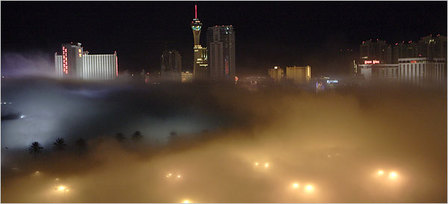 Dust from the implosion of the Stardust. Source of the photo: online version of the NYT article cited below.
Dust from the implosion of the Stardust. Source of the photo: online version of the NYT article cited below.
If any city in the United States has dynamism, it is Las Vegas. Yet, note in the passage below, that even in Las Vegas there are those who want dynamism to die.
Las Vegas has become known in recent decades for tearing down the notable resorts that first put the Strip on the map, and famous places like the Dunes, the Hacienda and the Sands have been replaced by the Bellagio, the Mandalay Bay and the Venetian.
“The Stardust was the Bellagio of its day, the most dazzling casino out there,” said Nicholas Pileggi, who spent four years researching the exploits of Frank Rosenthal, the mobster who ran the Stardust, for his best-selling nonfiction book “Casino” and the fictionalized screenplay for the Robert DeNiro film of the same name. “But time moves on.”
The oldest casino structure on the Strip now is a part of a coffee shop at the Sahara and dates back just 55 years.
“Unlike most other cities, we in Las Vegas reinvent ourselves all the time,” Mr. Boyd said. “In order to keep up with the competition, you have to keep improving your product. That’s what we’re going to do here at the Stardust. But we still have great memories.”
Some are not so accepting of the changes in the city. Joel Rosales, 23, owns the Web site LeavingLV.net, which pays tribute to each property that is razed.
The loss of the Stardust, Mr. Rosales said, is particularly disappointing.
“Having been born and raised here in Vegas, it’s always been a rock,” he said of the resort. “I wouldn’t say I’m as upset as I am disappointed that we as a city have no sense of preserving our past and heritage, no matter how tacky or out-of-date it may be.”
For the full story, see:
 Celebration of, and then demolition of, the Stardust. Source of the photo: online version of the NYT article cited above.
Celebration of, and then demolition of, the Stardust. Source of the photo: online version of the NYT article cited above.

